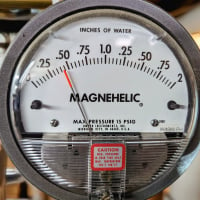Best Of
Re: Old fridge
LOL, I was wrong - it's not a post war fridge like I always thought it was. Curiosity got the better of me so I pulled it out and looked behind it - the model is B6-39-A, so it's over 85 years of continuous operation.
I'm selling my commercial building this summer where it's at - do these have any value or should I just leave it with the buyer? It needs to be stripped and painted and it needs a new gasket, but otherwise it's ice cold and dead quiet.
 MaxMercy
MaxMercy
Re: Stealing Steam Boiler Water for Hydronic Baseboard?
Well, technically you are correct on a leaking pump seal — or for that matter any leak on the pumped loop — emptying the boiler. That's one of the reasons, among many, for having a LWCO. The Hartford Loop, however, still protects the boiler against a leaking wet return, and since that is by far the most common sources of leaks in a steam system, why not have it?
You could, in principle, have a hot water radiator fed that way on the first floor. There are several ways to do it — the simplest being to have it up there and make sure it has no leaks, so that once it is purged a standard circulator can circulate it. However, a standard circulator likely will not be able to fill it if is allowed to empty for any reason. A higher head pump would work — provided there is enough head to avoid cavitation at the inlet. Another approach would be to use a heat exchanger and run a normal closed hydronic loop… more complicated.
Re: Mystery tool
Thanks everyone! Talk about crowd-sourced knowledge. Even better than AI!
So I'm going with "It's a bronze bed bolt wrench that can also be used safely on gas lines due to the inherent safety of non-sparking bronze, and can also be used on anything that happens to have a square-head bolt of 7/16", 1/2", or 5/8" size."
Re: Mystery tool
Meanwhile, here is an eBay listing for an old iron "bed wrench" marked "A L Firmin", which was a Boston cabinet company. As Firmin was a maker of cabinet hardware, not gas fittings or plumbing supplies, the bed wrench seems a more likely intended use.
Re: Mystery tool
Hi, I was curious to see what the bed bolts looked like that this wrench would fit, so did a search. Here's what I got. Looks like a good fit 😉
Yours, Larry
Re: Mystery tool
As a plumber I can say that the Whitechapel is a tee wrench and your wrench is a wye. So I am going to double down on it being a gas cock wrench and say it is very similar to the other wrench, but not the same. Bronze would be fairly expensive for a wrench to tighten bed frames.
Re: Mystery tool
That is an antique bed key wrench for assembling and disassembling antique beds.
My research shows they're from the 19th century.
It was known that firefighters would often carry them to dismantle a family's bed in an effort to save them from a fire, as they were often a family's most expensive possession.
You can purchase these on eBay for about 10 bucks.
Re: Old fridge
I believe there's some custom gaskets out there for certain ones but for Monitor Tops etc off the shelf weather stripping etc works excellent.
The door latch is only an issue when leaving refrigerators outside where kids are likely to climb in them. this is why years ago people were told to remove the doors when throwing them out. When assembled and in use I'm not even sure anyone could ever fit in between the racks etc. I don't think it's possible with a Monitor Top.
 ChrisJ
ChrisJ
Re: Mystery tool
I'm thinking that the whole "fireman's" bed wrench is apocryphal. It probably comes from a corruption of "A L Firman". Yes, it is a wrench for square-headed bolts. Beds and many other things could have been assembled with square-headed lag bolts "back in the day." Hard to imagine every "fireman" being issued one of these and harder yet imagining him fumbling and taking the time to disassemble a burning bed. I thin he'd rather smash the bed frame with a proper "fireman's" AX. By the way a real "bed wrench" is a wooden tool for tightening the rope "grid" strung underneath the mattress (hence the term…."Sleep tight. Don't let the bedbugs bite."
https://d3h6k4kfl8m9p0.cloudfront.net/stories/V6dkxx8VZzglp4b.ub7Zcg.jpg





